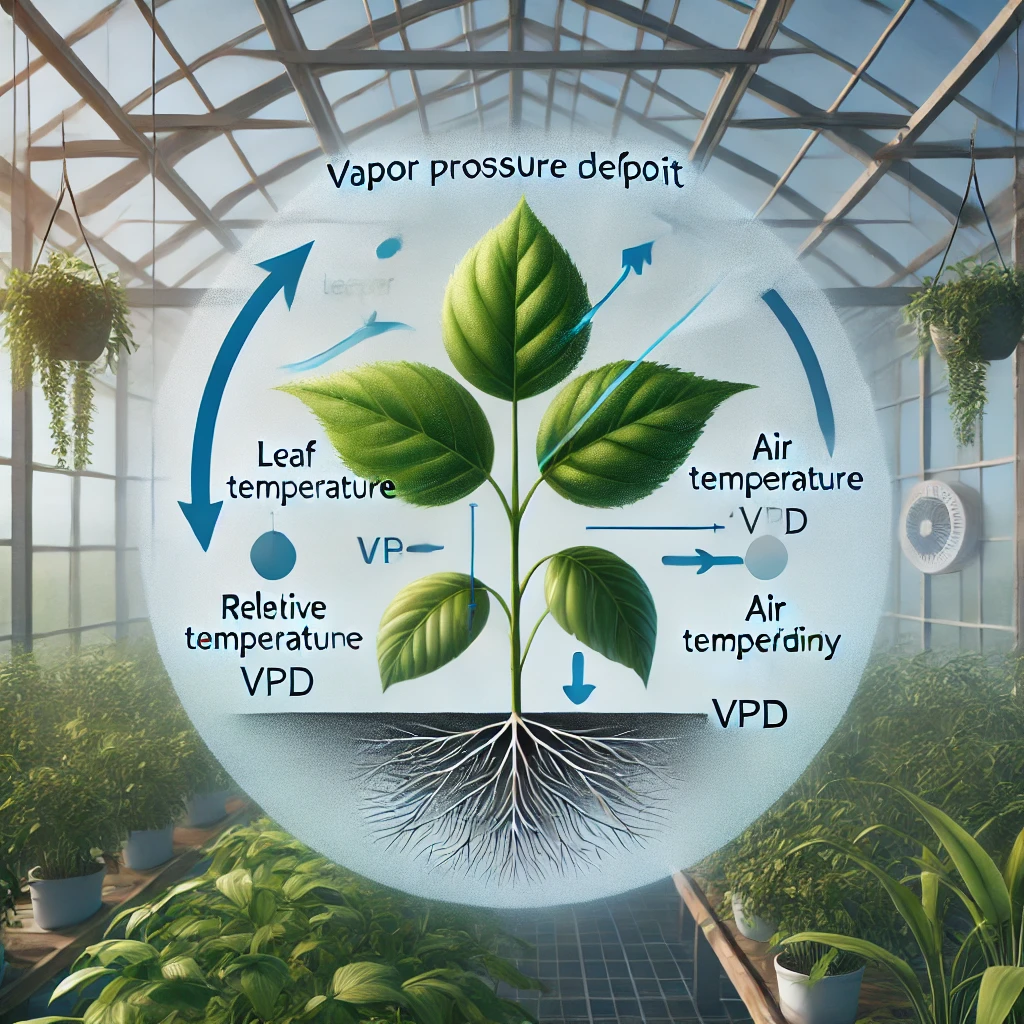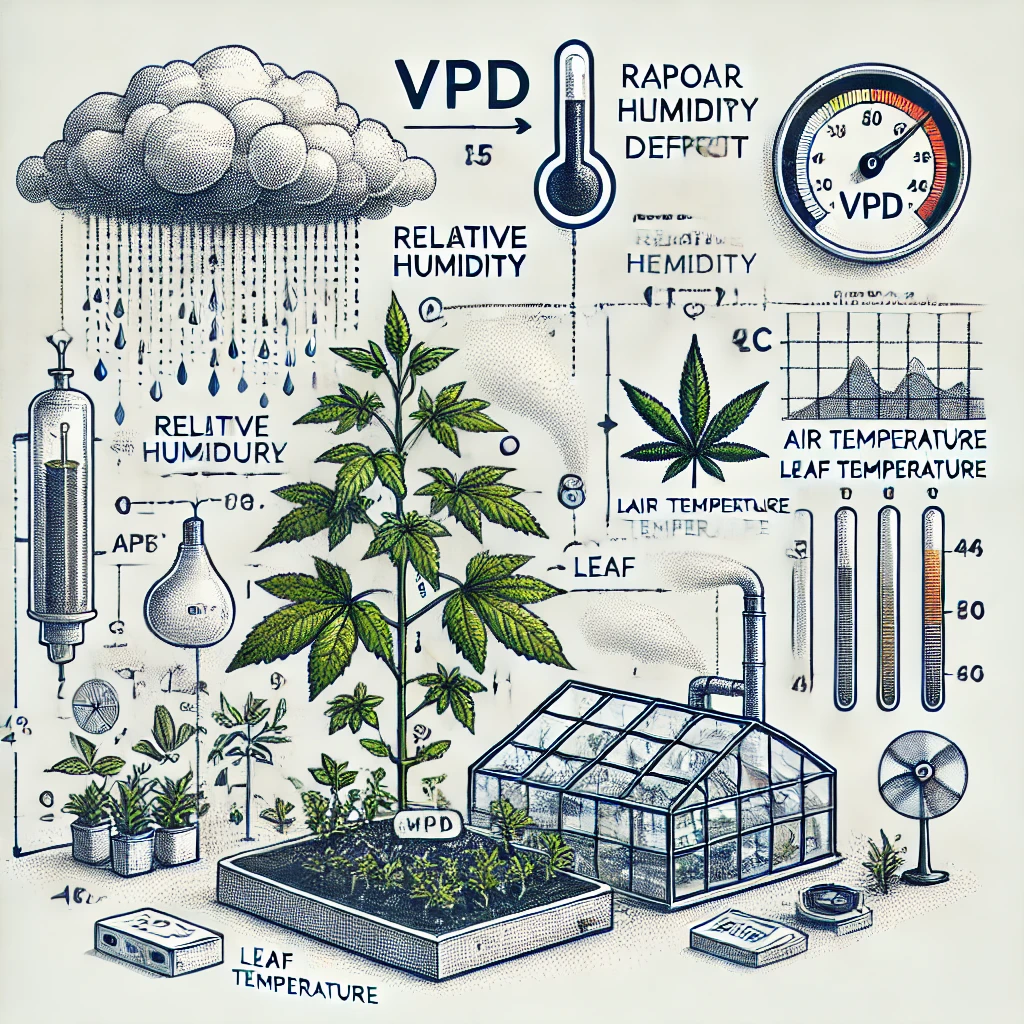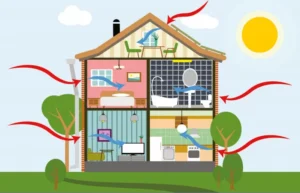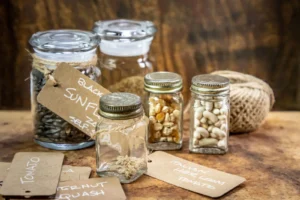The Vapor Pressure Deficit (VPD) Calculator is a vital tool in horticulture, providing valuable insights into the growing environment for plants. Vapor Pressure Deficit, or VPD, refers to the difference between the amount of moisture in the air and the moisture present in a plant’s leaf. VPD helps growers control transpiration rates, improve plant health, and optimize yields, especially in controlled environments like greenhouses.
VPD (Vapor Pressure Deficit) Calculator
| Air Temperature (°F): | |
| Leaf Temperature (°F): | |
| Relative Humidity (%): | |
| VPD: — kPa | |
In this article, we’ll discuss:
- The definition of VPD;
- The importance of calculating VPD for plant growth;
- How VPD differs from relative humidity;
- Interpreting VPD charts; and
- Sample VPD calculations.
We’ll also touch on how VPD plays a critical role in plant transpiration and offer practical examples of how to calculate it for use in a growing environment.
What Is Vapor Pressure Deficit (VPD)?

Vapor Pressure Deficit (VPD) is a measure of the drying power of the air in relation to the plant’s water content. More specifically, it represents the difference between the vapor pressure inside a plant’s leaf and the vapor pressure of the surrounding air. This value is typically expressed in pressure units like kilopascals (kPa).
VPD is significant in horticulture because it directly impacts the rate at which a plant loses water through transpiration. Plants transpire through tiny openings in their leaves known as stomata. When VPD is high, the air is dry, and plants lose water quickly, increasing transpiration. When VPD is low, the air is humid, and transpiration occurs more slowly. Regulating VPD helps maintain a balance between water loss and nutrient uptake, which is critical for plant growth.
Why Is VPD Important?
Maintaining an optimal VPD level is crucial to promoting healthy plant growth. A higher VPD can increase transpiration, allowing the plant to take in more nutrients from the soil. However, excessively high VPD levels can lead to water stress, where the plant closes its stomata to conserve water, reducing growth.
On the other hand, lower VPD levels can decrease transpiration. While this may seem beneficial, especially for young plants or seedlings, very low VPD levels can result in issues like reduced gas exchange and the increased risk of diseases like mildew. This is particularly relevant in humid environments where moisture accumulates on plant surfaces.
Balancing VPD is key to maximizing plant health and productivity in commercial growing environments.
VPD and Relative Humidity: What’s the Difference?
Many growers might wonder why they should bother with VPD when they can just monitor relative humidity (RH). After all, RH also measures moisture in the air. However, there are critical differences between these two concepts.
Relative humidity measures the amount of moisture in the air relative to how much moisture the air can hold at a specific temperature. The problem with RH is that it changes based on temperature. For example, air at 60% RH at 35°C is drier than air at the same RH but at 18°C. This variability makes it less useful for calculating the drying power of the air, especially across temperature variations.
Vapor pressure, on the other hand, is an absolute measure of the water vapor content in the air and does not fluctuate with temperature. This makes VPD a more reliable metric for assessing the environmental conditions affecting plant transpiration.
In short, VPD gives growers a better idea of the actual drying power of the air surrounding their plants, helping them regulate water loss and nutrient absorption more effectively.
How to Calculate Vapor Pressure Deficit (VPD)

Now, let’s get into the nitty-gritty of calculating VPD. The formula for VPD is:
$$[ \text{Vapor Pressure Deficit} = \text{Vapor Pressure of Leaf} – \text{Vapor Pressure of Air} ]$$
To calculate VPD, you’ll need three key variables:
- Air Temperature;
- Relative Humidity; and
- Leaf (Canopy) Temperature.
Leaf temperature is usually a few degrees cooler than the surrounding air temperature due to evaporative cooling from transpiration. You can measure this using an infrared thermometer or an aspirated air temperature sensor located near the plant canopy.
The most commonly used equation to calculate the vapor pressure of air and leaf is the Tetens equation. This equation calculates the saturation vapor pressure for water at a given temperature:
$$[ \text{Saturation Vapor Pressure} = 0.61078 \times \exp\left( \frac{17.27 \times T}{T + 237.3} \right) ]$$
Where:
- ( T ) = Temperature in °C
- $$( \text{Saturation Vapor Pressure} )$$ is expressed in kilopascals (kPa)
For the actual vapor pressure of the air, multiply the saturation vapor pressure by the relative humidity (expressed as a decimal, where 60% RH is written as 0.60):
$$[ \text{Vapor Pressure of Air} = \text{Saturation Vapor Pressure of Air} \times \text{Relative Humidity} ]$$
Assume the leaf temperature is 100% saturated (100% RH), meaning the leaf’s vapor pressure equals the saturation vapor pressure of the leaf:
$$[ \text{VPD} = \text{Saturation Vapor Pressure of Leaf} – \left( \text{Saturation Vapor Pressure of Air} \times \text{Relative Humidity} \right) ]$$
This gives you the VPD value in kilopascals (kPa).
Sample VPD Calculation
Let’s break down a sample calculation using common greenhouse conditions:
- Air temperature = 22°C
- Relative humidity = 55% (0.55)
- Leaf temperature = 20°C
- Step 1: Calculate the Saturation Vapor Pressure of the Leaf
Using the leaf temperature of 20°C, plug the value into the Tetens equation:
$$[ \text{Saturation Vapor Pressure of Leaf} = 0.61078 \times \exp\left( \frac{17.27 \times 20}{20 + 237.3} \right) ]$$
$$[ \text{Saturation Vapor Pressure of Leaf} = 2.338 \, \text{kPa} ]$$
- Step 2: Calculate the Saturation Vapor Pressure of Air
Next, calculate the saturation vapor pressure of air using the air temperature of 22°C:
$$[ \text{Saturation Vapor Pressure of Air} = 0.61078 \times \exp\left( \frac{17.27 \times 22}{22 + 237.3} \right) ]$$
$$[ \text{Saturation Vapor Pressure of Air} = 2.644 \, \text{kPa} ]$$
Now, multiply by the relative humidity:
$$[ \text{Vapor Pressure of Air} = 2.644 \times 0.55 = 1.454 \, \text{kPa} ]$$
- Step 3: Calculate VPD
Finally, subtract the vapor pressure of air from the vapor pressure of the leaf:
$$[ \text{VPD} = 2.338 \, \text{kPa} – 1.454 \, \text{kPa} = 0.88 \, \text{kPa} ]$$
Interpreting VPD Values
So what does this calculated VPD value mean for your plants? Here’s a basic breakdown:
- Low VPD (0.3–0.7 kPa): Indicates a very humid environment. This may be useful during early growth stages, but it can increase the risk of fungal diseases if sustained for too long.
- Optimal VPD (0.8–1.2 kPa): Ideal range for most plants, promoting healthy transpiration rates and robust growth.
- High VPD (1.3–2.0 kPa): Indicates a dry environment. While it can encourage nutrient uptake through faster transpiration, prolonged high VPD levels can lead to water stress and hinder growth.
Using Dew Point and Wet-Bulb Temperature in VPD Calculation
In some instances, you might not have all the data needed to calculate VPD using air temperature and relative humidity. In these cases, you can use alternative measurements like dew point or wet-bulb temperature to estimate VPD. By calculating dew point, you can control the air’s moisture content and indirectly manage VPD, providing greater flexibility for growers in automated systems.





